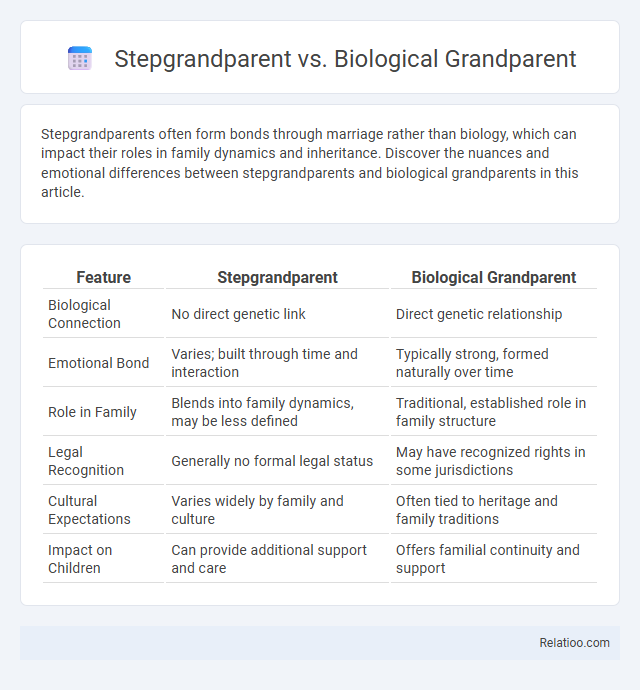Stepgrandparents often form bonds through marriage rather than biology, which can impact their roles in family dynamics and inheritance. Discover the nuances and emotional differences between stepgrandparents and biological grandparents in this article.
Table of Comparison
| Feature | Stepgrandparent | Biological Grandparent |
|---|---|---|
| Biological Connection | No direct genetic link | Direct genetic relationship |
| Emotional Bond | Varies; built through time and interaction | Typically strong, formed naturally over time |
| Role in Family | Blends into family dynamics, may be less defined | Traditional, established role in family structure |
| Legal Recognition | Generally no formal legal status | May have recognized rights in some jurisdictions |
| Cultural Expectations | Varies widely by family and culture | Often tied to heritage and family traditions |
| Impact on Children | Can provide additional support and care | Offers familial continuity and support |
Introduction: Defining Stepgrandparents and Biological Grandparents
Stepgrandparents are individuals who become grandparents through marriage rather than blood relations, while biological grandparents share a direct genetic connection to their grandchildren. Your family dynamic may include both stepgrandparents and biological grandparents, each playing unique roles in your life. Understanding the distinctions helps clarify relationships and expectations within blended families.
Family Roles: Key Differences and Similarities
Biological grandparents share genetic ties with their grandchildren, often influencing family traditions and hereditary traits, while stepgrandparents form bonds through marriage without biological connections, focusing on emotional support and caregiving roles. Both stepgrandparents and biological grandparents contribute to family stability, offering guidance, love, and intergenerational wisdom, although stepgrandparents may face challenges in establishing authority or acceptance initially. Similarities lie in their roles as nurturers and mentors, but key differences include genetic linkage, legal considerations, and varying degrees of social recognition within the family structure.
Emotional Bonds: Building Relationships Across Generations
Emotional bonds between stepgrandparents and grandchildren often develop through shared experiences and consistent interaction, even without genetic ties, highlighting the importance of quality time and mutual respect. Biological grandparents may have an inherent connection due to family history, but building strong relationships requires effort and emotional investment to deepen trust and affection. Your opportunity to foster meaningful connections lies in embracing the unique roles each grandparent plays, nurturing love that transcends biology.
Legal Rights and Responsibilities
Biological grandparents generally have established legal rights and responsibilities, including visitation and custody considerations, based on their genetic ties and family laws in most jurisdictions. Stepgrandparents' legal rights are less defined and often require formal adoption or court orders to gain similar standing, making their responsibilities more conditional and dependent on specific legal actions. Understanding how these distinctions affect Your family dynamics is crucial for navigating custody, visitation, and inheritance matters effectively.
Cultural Perspectives on Grandparenting
Cultural perspectives on grandparenting vary significantly between stepgrandparents and biological grandparents, influencing family roles and emotional bonds. Biological grandparents often hold traditional authority and are seen as custodians of heritage, while stepgrandparents may navigate acceptance challenges but can enrich family dynamics through unique support and caregiving roles. Understanding these cultural nuances helps you appreciate diverse grandparenting experiences and fosters empathy across blended family structures.
Challenges Faced by Stepgrandparents
Stepgrandparents often face unique challenges such as establishing trust and meaningful bonds with step-grandchildren compared to biological grandparents who typically share a direct genetic connection. Navigating family dynamics and defining their role without clear societal expectations can complicate relationships, especially when parental figures hold differing views on boundaries. You may experience emotional complexities as stepgrandparents strive to balance respect for biological family ties while fostering your own supportive and influential presence in the family structure.
The Impact on Grandchildren: Navigating Complex Family Dynamics
The impact on grandchildren varies significantly between stepgrandparents and biological grandparents, as biological grandparents often provide a sense of genetic continuity and heritage, while stepgrandparents contribute through emotional support and blended family roles. Your grandchildren may experience loyalty conflicts, identity questions, and shifting attachments as they navigate these complex family dynamics. Understanding the distinct roles of each grandparent type can help foster stronger, more secure relationships within blended families.
Practical Tips for Fostering Healthy Relationships
Establishing trust and open communication is crucial when navigating relationships between stepgrandparents, biological grandparents, and grandchildren. Respecting each other's roles and boundaries helps reduce conflict and supports a harmonious family dynamic. You can foster healthy relationships by encouraging inclusive activities and acknowledging the unique contributions each grandparent brings to the family.
Communication Strategies for Blended Families
Effective communication strategies for blended families require recognizing the unique roles of stepgrandparents and biological grandparents in children's lives. You can foster harmony by encouraging open dialogue, setting clear boundaries, and promoting mutual respect among all grandparents. Emphasizing active listening and empathy helps bridge differences, ensuring that both stepgrandparents and biological grandparents contribute positively to family cohesion.
Conclusion: Embracing the Modern Grandparent Role
Your family dynamics evolve as stepgrandparents and biological grandparents both play essential roles in providing love, support, and guidance. The modern grandparent role embraces inclusivity, recognizing that emotional bonds and shared experiences often outweigh biological connections. Valuing each grandparent relationship enriches your family's sense of unity and belonging.

Infographic: Stepgrandparent vs Biological Grandparent
 relatioo.com
relatioo.com